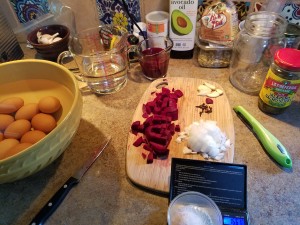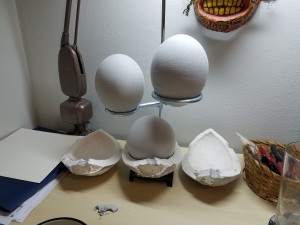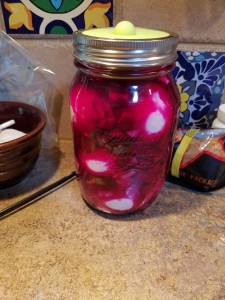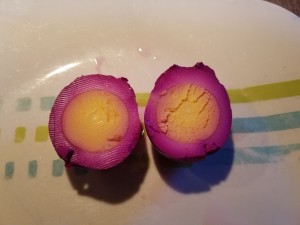Pickled Eggs
July 27, 2019
Eggs! Eggs! Eggs! Completely obsessed. Here are three clay ostrich eggs I made with the plaster mold from our last craft day:
Obviously, the next step is to bring together crafting and pickling!
I started with this recipe. It’s salt by volume (argh!) so I converted to metric and weight. 17g salt / 118 ml = 14% Dang that’s very salty! I don’t think lactobacilli can thrive in that, can they? Another recipe said 1T salt with 1c water, only 7% salinity. A third said 1T with 2c water! There doesn’t seem to be a standard amount.
Another mystery, all the recipes I found don’t have any sugar in them. Lactobacilli eat sugar, eggs have none, what do they eat to produce the acid that pickles the eggs?
Alrighty, I’m going to try my own recipe. Rather than add sugar, I’ll add sweet vegetables to provide food for the lactocritters. I have some leftover brine from a batch of beets, that’s going in too giving the brine a fermentation jump start and extra purple dying for the eggs. I’ll mix additional salt water at 3.5% saline, the lowest I found in recipes but higher than most vegetable ferments… this should still be salty enough to inhibit bad bacteria.
- 9 cloves
- 5 cloves garlic
- 1 dozen eggs, boiled soft to medium and peeled
- diced beets
- diced onion
- canned jalapeño slices
- 200ml beet brine, completed fermentation with 2% saline
- 500ml water, 3.5% saline
For the eggs, I put them in water, brought to a boil, turned it off and waited 7 minutes, then dunked in an ice bath before peeling. I’m shooting for softer yolks b/c I believe the acidic ferment will firm them up more and I don’t want them to come out dry.
Pack the jar starting with the garlic and cloves on the bottom. Add a couple eggs in and fill the spaces around them with beets, onions, and jalapeños. Continue this way up to about 2 inches from the top of the jar. I used one of those fatter mason jars to get more eggs in.
Pour in the beet brine. Pour in salt water up to the 2″ line. If using a pickling cup, fill just past the bottom of the cup. Screw on your airlock lid and set on the counter.
In the end I used 150ml of the beet brine and 100ml of the fresh saline.
((150 * .02) + (100 * .035)) / 250 = about 2.5% saline.
That’s lower salinity than recipes on the internet but I’m not worried. This should be enough to avoid spoilage and lactobacilli are really good at eating other microorganisms.
The recipes all say 3 days which again confuses me… vegetable brine pickles take a week to complete primary fermentation, lowering the pH to pickling strength. How could there be enough acid in the jar after only 3 days? I’m going to measure with a pH meter every day.
If push comes to shove, I’ll drain some of the brine and add vinegar to finish pickling the eggs in the refrigerator.
UPDATE Wednesday 7/31/2019
These came out great! I tasted an egg in Tuesday and it was tasty so I put them in the fridge. Surprisingly, the brine is tart so the lactocritters had enough time to do their job. Next time I think I’ll add a few cloves and use more jalepenos.
Filed under: Uncategorized | Comments (0)


